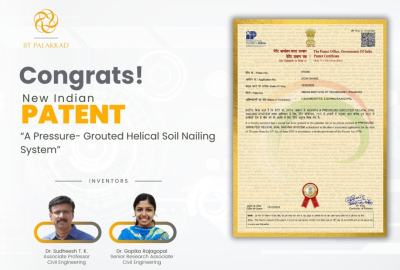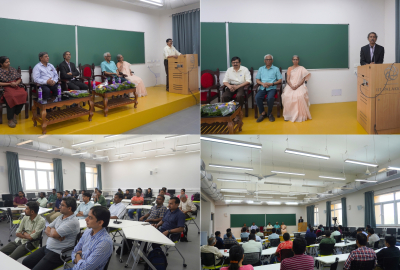
Day 7 of Science Quest and CRYSTAL: Fun with Physics
As on previous days, May 10th, the seventh day of the ongoing residential Science Camp for school students witnessed some parallel sessions for the Junior and Senior batches of students to begin with, and combined sessions later in the day. Dr Prithvi Narayan P and Dr Amit Kumar Pal spoke to the senior batch about the Large Hadron Collider and Quantum Technologies respectively. Dr. Prithvi offered an introduction to different length, energy and temperature scales associated with particles and some of the experiments (like Rutherford scattering) used to study them. The components, working and the engineering challenges in building a Large Hadron Collider (LHC) and its relevance in studying the standard model and discovery of the Higgs Boson in 2012 were also discussed. The knowledge that LHC is able to accelerate protons close to speed of light and reproduce conditions that existed within a billionth of a second after the Big Bang fascinated the curious minds attending the session. The last few minutes of the session were for doubt clearing and interaction.
The second session was a talk by Dr. Amit Kumar Pal, on the topic Quantum Technologies. A basic introduction to the term ‘Quantum’ and idea of dual nature of particles and superposition of states was given to the students. Schrodinger’s famous thought experiment was also discussed. The latter half of the talk mainly sought to motivate students about the need to develop Quantum technologies by explaining some of the drawbacks in classical computers (like data storage) and a few problems that cannot be solved using classical computers. The session was very informative and interesting.
Dr Projjwal Banerjee facilitated a session on The Origin of the Universe for the junior batch. Two Phd scholars were on hand to translate the specific words and concepts covered to Malayalam for the Class V-IX students. Students offered their understanding of ‘universe’ as ‘Place we live in, includes everything’. Dr Projjwal drew from that to point out that the earth is the more immediate place we live in, and how it is part of the solar system, and a galaxy, which is part of the Universe. This set the stage for the core foci of his talk which were: How big the universe is, and how the universe began. He spent considerable time explaining how we need to ‘zoom out’ and understand distances to the order of 1000s of kilometers to begin to understand the size of the universe. The distance between the earth and sun is roughly 1000 times the size of the sun. A unit which is a lot of kms comes handy and that is a light year. The distance travelled by light in one year or 1 ly is roughly 1000 times the length of solar system. To put that in perspective, if a 1 metre scale is 1 ly, the solar system would be 1millimetre on it.
Starting from a map of all stars around the sun within a radius of 20ly (109 stars) with every star 2-3 ly away from the other, the session progressed to consider zooming out in stages and by a factor of 10 each time. At a radius of 250ly, the number of stars increases to 260000 , and zooming out further the Orion Arm has 6million stars, with stars in strips, and the Milky Way Galaxy of which it is a part has 2 billion stars. Satellite galaxies around the Milky Way, empty space between the galaxies, 225bn stars in the 12 dwarf galaxies were all added to the portion of the universe under consideration. Neighbouring large galaxies, the Virgo Supercluster (200 trillion stars/ 2500 large galaxies) and the Cluster of Superclusters that is the Universe (2,50,000 trillion stars/ 3mn large galaxies) came alive in this manner.
Noting that before 1929, and Edwin Hubble’s phenomenal work with his large space telescope, much that we know today about the universe, was not known, Dr Projjwal proceeded to talk about how the universe is expanding. It was Hubble who noted that galaxies are moving away from us in every direction and also that, the farther they are, the faster they are receding. These observations marked the beginning of our current understanding of how the universe began.
Drawing analogies to how dots marked on a balloon will move further and further away from each other as the balloon is inflated and expands, or how when a bomb explodes, parts of its shell will travel away from the point of explosion, he stated that if we go back in time, the universe would have been highly condensed matter and energy contained in a point that exploded. This is the Big bang theory. Explaining Einstein’s work in simple terms, he said mass and energy contained in a very small volume will explode. Space and time are related to each other. The universe was once a point of the size of 10 to the power of minus 35 metres. That the theory correctly predicted the existence of relic photons of the Big Bang, which do exist - 400 per cubic centimetre, popularized it, as well as its ideas of ordinary matter, dark matter and dark energy.
The Junior batch had a quiz organized for them by Research Scholars of the Physics Department in the second half of the morning, and all students were treated to some demonstration experiments in the second half of the day. Dr. Jayakumar Balakrishnan, Dr Bibhu Ranjan Sarangi, Dr Vishwas Venkatesh and Dr. Soham Manni took charge of the demonstrations and fun experiments, assisted by lab staff. Concepts of Pressure, Refractive Index, Viscosity, non-Newtonian liquids and Interaction forces between particles were discussed. The students were called upon to try out the experiments which made the session all the more cheerful and fun. The highlight of the session was when the students were shown liquid Nitrogen and the low temperature that can be attained using it.






